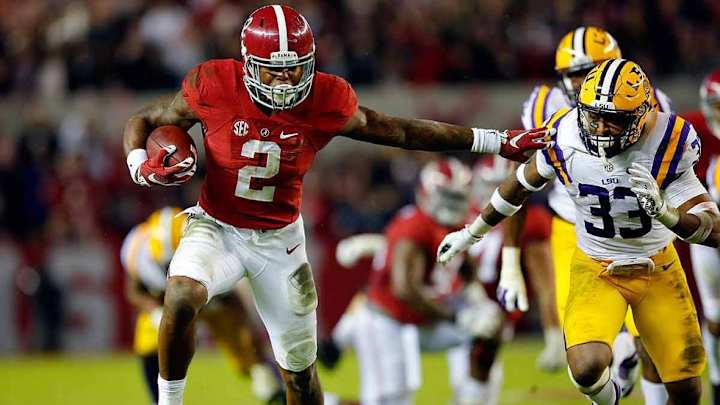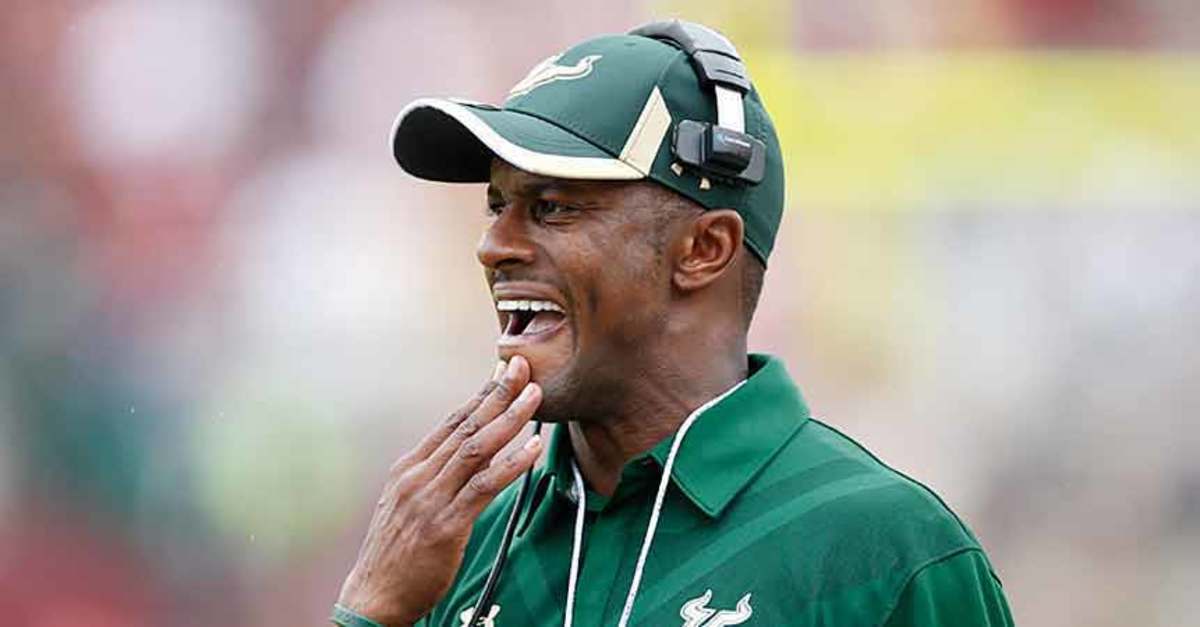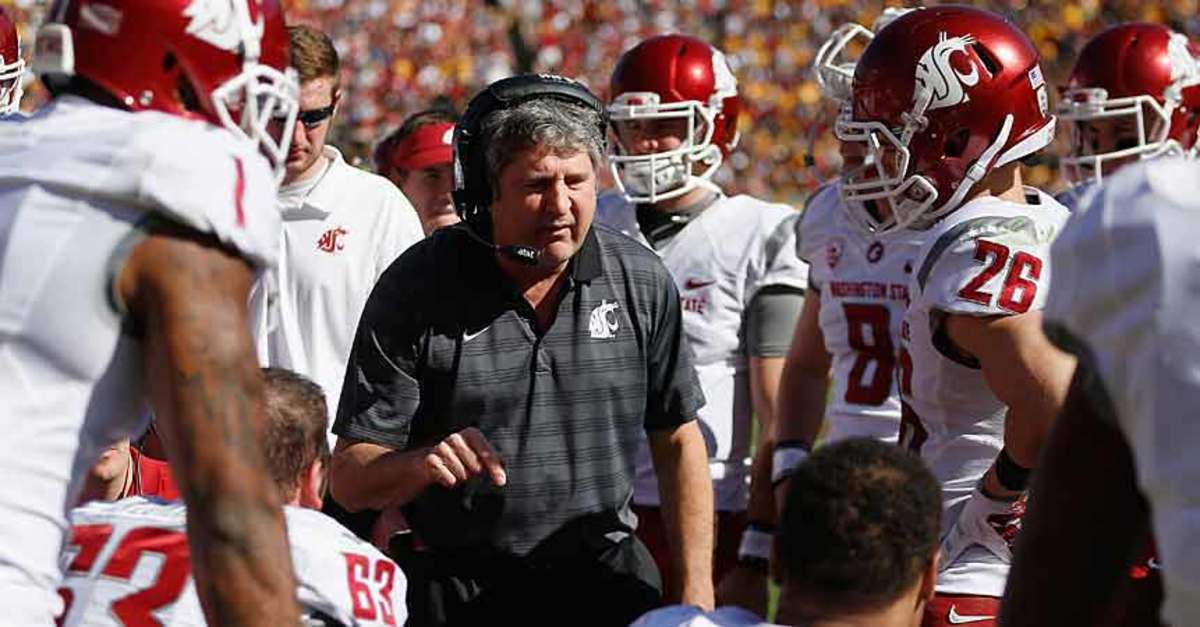Derrick Henry, Ezekiel Elliott, Leonard Fournette all having stellar seasons in Year of the Running Back

Only two running backs have won the Heisman Trophy since 1999. Alabama's Mark Ingram captured the award during the Crimson Tide's 2009 title season and USC's Reggie Bush pirouetted and front-flipped his way to immortality in 2005.
There's a strong chance that a third running back will be joining that list in 2015, as the only thing certain in this muddled Heisman Trophy race is that there will be an anomalously large running back contingent in New York City next month.
It's too early to handicap the Heisman Trophy race with any degree of certainty, a lesson learned after many crowned Leonard Fournette as the winner before November. But it's not too early to declare 2015 the Year of the Running Back, as there could be four backs among the top five Heisman Trophy finalists this season.
Alabama's Derrick Henry is this week's presumed leader, something that could certainly change by the second week in December. Henry already has 19 rushing touchdowns and has likely secured at least an invitation to New York. While there, he's certain to be joined by an impressive tailback crew—Florida State's Dalvin Cook, Ohio State's Ezekiel Elliott and Stanford's Christian McCaffrey all have a great shot at being Heisman Trophy finalists as well. And before we completely disregard Fournette after back-to-back clunkers against Alabama and Arkansas, let's remember that he still leads the nation with 1,474 rushing yards. (And that's with one fewer game than Henry, Elliott and McCaffrey.)
There will likely be a quarterback or two joining them in New York with Oklahoma's Baker Mayfield and Clemson's Deshaun Watson the leading candidates. But it would be a surprise at this point if a tailback didn't win the trophy and the majority of the top five vote getters aren't running backs.
To show what a departure it is to have tailbacks so dominant as the best players in college football, consider that the last time three running backs were among the top five Heisman Trophy vote getters was back in 2006. Arkansas's Darren McFadden, West Virginia's Steve Slaton and Michigan's Mike Hart filled out the top five with Notre Dame quarterback Brady Quinn behind winner Troy Smith of Ohio State.
The top five of the Heisman voting surely isn't a scientific method of researching top tailbacks, but it does serve as a bellwether for the most dominant players of the season. The run of quarterbacks winning the Heisman and generally crowding the top five every year comes amid the rise of an era of football where tempo, spreading the field and wide-open passing games became the dominant style. Somewhere between Bush in 2005 and Oregon quarterback Marcus Mariota last year, pro-style and run-heavy offenses evolved from the norm in college football to outliers.
So how did we get here? How in the era of five wide and pass-happy coordinators and allergies to huddles did a college football rediscover its between-the-tackle roots? Is this evidence that there's momentum shifting back to multiple tight-end sets and run-first teams again becoming the convention in college football?
Well, there's a handful of explanations and it depends on who you ask. Arkansas coach Bret Bielema said on Sunday night that "there's absolutely a shift" and that he thinks "football is moving" back that way. Mississippi State defensive coordinator Manny Diaz, who has attempted to gameplan against Fournette and Henry this season, has a simpler explanation. "There's nothing I can think of big-picture wise," he said. "Just a run of some really talented guys with unusual size and speed. I think Fournette and Henry would be freaky no matter what era they played in."
Fournette and Henry are cut from the same freaky archetype and had have rare blends of size and speed. Henry is 6' 3" and 242 pounds yet could be seen sprinting away from Mississippi State defensive backs on touchdown runs of 74 and 65 yards on Saturday. Fournette is also uniquely nimble for a 6' 1" 230-pound tailback, as he can push a pile and run over or around opposing linebackers.
Elliott checks in at 6-feet and 225 pounds, meaning he's not quite as big as Fournette and Henry. But he's powerful, as evidenced by his highlight reel of blocking players off the ball. What separates Elliott is his blended talent, as he excels at pass protecting and catching the ball from the backfield. He also can run between the tackles as efficiently as he can dance around the edge.
Cook may be the least heralded of the group, but he's averaging 8.1 yards per carry and is second nationally with 152.1 yards per game. McCaffrey, who is 6-feet and 201 pounds, may have the most pure explosion out of all the top backs. He leads the nation in all-purpose yards (241.8) by a country mile thanks to his special teams versatility (San Jose State's Tyler Ervin is No. 2 at 209.8).
So why the gaudy running back numbers? One theory an NFL scout offered makes some sense. He pointed to the cyclical nature of football as defenses have become so prepared to stop spread offenses by becoming more nimble and versatile that they aren't as equipped to stuff the box and slow the run game. "There's been such a priority placed on the edge and stopping the spread that teams are susceptible to the run game," the scout said.
While that evolution is certainly true, it's doesn't fit for this elite tailback crew. Four of the five play in smashmouth pro-style offenses, with Ohio State's Elliiott the exception. "There's no shift that I can feel," says Buckeyes defensive coordinator Chris Ash, speaking generally of the trend. "Other than it just happens to be a season with some talented running backs on teams that might not have an elite quarterback and have to run the ball more."
That observation rings particularly true for Alabama, LSU and Florida State, none of which have been able to rely on a consistent downfield passing game this season. Instead they have pounded the ball with their dominant backs. "Those guys are special players," says Clemson defensive coordinator Brent Venables. "Anytime you have an Adrian Peterson-type of guy, you'd be a fool as a coach not to feature him. I think that's first and foremost. Even though it's a spread game and those types of things, the most successful teams, year in and year out, run the ball. You get race horse like that, you ride it."
Next year may be a better barometer whether this season of tailback dominance is an anomaly or a trend. But here's an early indicator that Bielema's prediction could be correct—Fournette, McCaffrey and Cook are all just sophomores. They'll be among the early favorites to win the 2016 Heisman Trophy, meaning this run on dominant running backs could continue next season.

Joe Robbins/Getty Images
Coach Willie Taggart has found right combination at USF
When Willie Taggart became South Florida's coach nearly three years ago, others recommended he needed to hire a staff of bigger-name assistants. "I was told I needed to do this, I needed to do that," Taggart tells The Inside Read. "I always said I was going to do it my way, but I went against my own word."
The result for Taggart was a rocky 6-18 record in his first two seasons. So with Taggart's job admittedly on the line this year, he reshuffled his staff in the off-season. He hired five new assistants, but this time they were coaches he was comfortable with—defensive coordinator Tom Allen, tight ends coach David Gilbertson, defensive backs Alonzo Hampton, co-offensive coordinator Danny Hope and running backs coach Donte Pimpleton.
"For what we had to rebuild here, we needed energy-givers, not energy-takers, to get it turned around," Taggart says.
The moves have worked this season with Taggart and his youthful team now bowl-eligible after its surprising 44-23 home rout of No. 22 Temple on Saturday night. It's the biggest triumph of Taggart's tenure with the Bulls. South Florida (6-4, 4-2 ACC) is still alive for the AAC's East Division title entering Friday night's game against Cincinnati (6-4, 3-3).
"They're all guys that wanted to be here," Taggart says of his coaching staff. "The new guys didn't have to come knowing the situation. If we didn't win this season, I wasn't going to be here anymore, but they wanted to be here and be a part of that. That was important to me and says a lot about them."
Some of Taggart's new hires were old faces. Hampton and Pimpleton had worked respectively as defensive backs coach and an offensive quality control assistant with Taggart in his previous job as Western Kentucky's coach. Allen had been Mississippi's linebackers coach and came at the recommendation of Taggart's good friend, Rebels coach Hugh Freeze. Under Allen, South Florida is 34th in the FBS in scoring defense per game (22.3 points), a jump of 31 spots from last season. "He's been a big-time hire for us," Taggart says of Allen.
Hope, the former Purdue coach, knew more about Taggart than vice versa. Hope had been Eastern Kentucky's coach when Taggart was an assistant at Western Kentucky. But Hope had coached with Taggart's former high school coach, Joe Kinnan, who Taggart brought on in February as a senior offensive analyst. Gilbertson was promoted from offensive graduate assistant. He is the son of former Idaho, California and Washington coach Keith Gilbertson.
"What was important was to get guys that care about our players, not just themselves," Taggart says. "That's paid off big time."
Many of Taggart's best players are still young and had to play as true freshmen because of the lack of talented upperclassmen when he took over. It's group led by sophomore running back Marlon Mack the AAC's reigning Rookie of the Year, and starting dual-threat sophomore quarterback Quinton Flowers.
Mack leads the AAC with 1,065 rushing yards and also has six touchdowns on 164 carries, while Flowers has thrown for 1,676 yards with 14 touchdowns and six interceptions this season to go with 747 rushing yards and eight touchdowns on 151 carries.
Taggart is excited for next season when transfer wide receiver Marquez Valdes-Scantling (North Carolina State), linebacker Cecil Cherry (Texas) and quarterback Asiantii Woulard (UCLA) are all eligible after sitting out this season.
"We're just getting started," Taggart says. "The future is so bright. What we're doing now is just setting it up for us in the future."
And Taggart has way loftier expectations than his team's coming bowl appearance, which will be the Bulls' first since 2010.
"We want to win multiple championships in a first-class manner," Taggart says. "That's what we're trying to build here. We want to be able to recruit big-time players and now that we're winning, we really can. We did a good job recruiting before considering our record."
South Florida's three previous recruiting classes under Taggart were each the best in the AAC. But on Sunday morning when Taggart met with coaching staff, he took time to live in the moment of what they have accomplished so far this season.
"I told them how proud I was of all of them," Taggart says. "How I appreciated every single one of them. I don't probably tell them that enough."
Taggart intends to do that more. Just like he's going to continue to stay true to himself.

Christian Petersen/Getty Images
After rough patch, Leach has steadied ship at Washington St.
As Washington State coach Mike Leach stood in the locker room after a stunning 24—17 season-opening home loss to Portland State in early September, he urged on his young team. It had been a miserable defeat to a veteran FCS team with similar size in a brutally cold downpour after the best off-season his players had since he arrived in Pullman nearly four years ago.
"We're better than that," Leach recalls telling his team. "Still in front of us is everything that we've worked for, but we have to stick together and work hard. We've got to eliminate the distractions. All that counts is who is in our room and nothing on the outside."
Leach emphasized all that in what he describes as "a variety of different ways and terms," but was particularly adamant about the outside influences. And for good reason, because until this season, Washington State hadn't had a single winning campaign in 12 years (even though Leach snapped the Cougars' decade-long bowl drought in 2013).
"That had to be unacceptable to us," Leach tells The Inside Read of his program's losing ways. "That wasn't going to necessarily be reinforced outside of our building. Don't get me wrong, our fans are great people, very supportive. They love the Cougs, but were conditioned for over a decade to not expect much. Those expectations couldn't come from outside. They had to come from us."
And those have been to be a Pac-12 contender, a leap Leach and Washington State (7-3, 5-2) have made this season entering Saturday's game against Colorado (4-6, 1-7). With their thrilling, last-minute 31—27 win at No. 19 UCLA on Saturday night, the Cougars are off to their best start since 2003 and ranked in the Associated Press poll for the first time since 2006 (No. 24).
This is also the first time since 2006 that Washington State has beaten UCLA and Oregon in the same season. "We're a team that hangs together until the end and expects to be successful," Leach says. "We've only scratched the surface of how good we can be."
Yet Washington State's bright future is what hampered the Cougars in their season-opening loss. They are predominantly a team of freshmen and sophomores.
"We just had too many people that really hadn't played college football," Leach says. "It was a tough environment to debut in, but we didn't play together well. It was just one of those steps we needed to take as a team to learn from and develop. We've done a good job of moving forward and improving and steadily getting better."
So has starting quarterback Luke Falk, who leads the nation in passing yards (4,067 yards) and is second in touchdown passes (35). The 6' 4", 205-pound redshirt sophomore is completing 70.3% of his passes this season, but threw for a season-low 289 yards in the Portland State loss.
"He's improved very quickly because he stays out of his own way," Leach says. "He's very even-tempered. He's not an emotional up-and-down guy. That makes the team calmer and more focused under fire. He does a really good job of leading that way by his own demeanor and presence out there on the field. He just never gets rattled. He's gotten better and better with that. He's got the ability to continue to improve as the game goes because he's not caught up dwelling on bad plays."
Leach hasn't dwelled on his team's loss to Portland State or its other two defeats this season at California and against Stanford by a combined eight points. "There was no doubt this could happen," Leach says of his team's success. "We just had to work together and put together the pieces. You've got to get everybody to believe it."
That's why Leach continues to preach to his team not to listen to those outside their locker room, despite winning five of their last six games. He lets his team enjoy their wins until they finish watching video of them on Sundays.
"There's a lot of talk and dialogue about improvement," Leach says. "We say that a lot."
Now, those are the type of expectations that Leach wants reinforced.
For a daily dose of college football insight, check out The Inside Read every weekday on Campus Rush.
